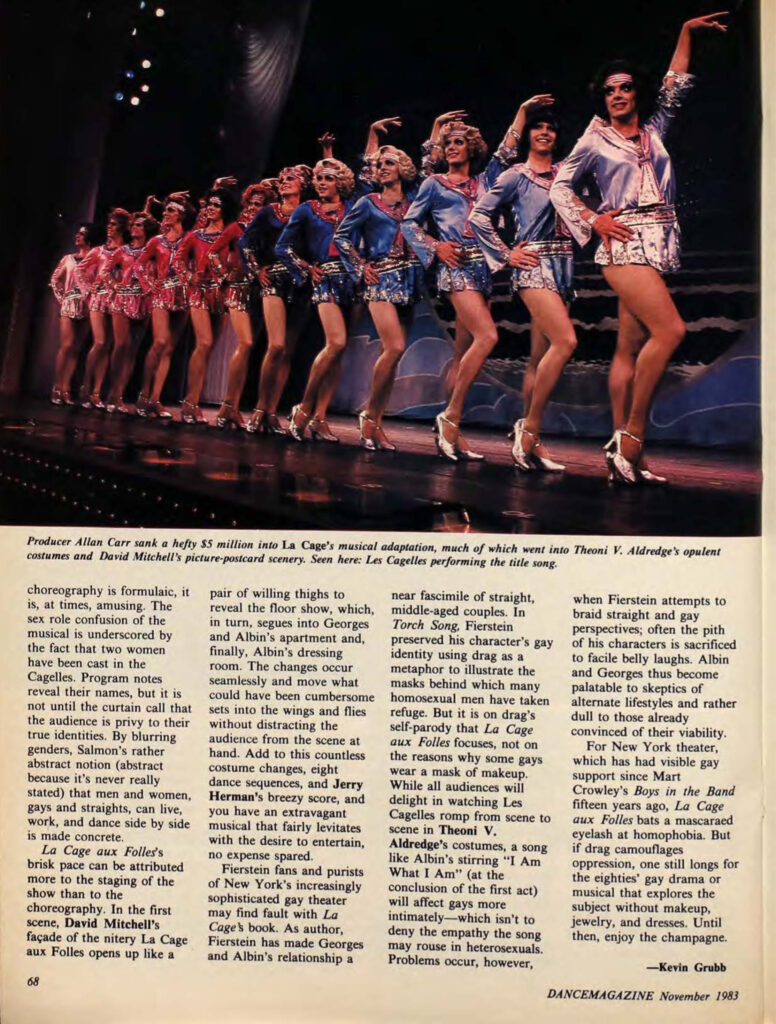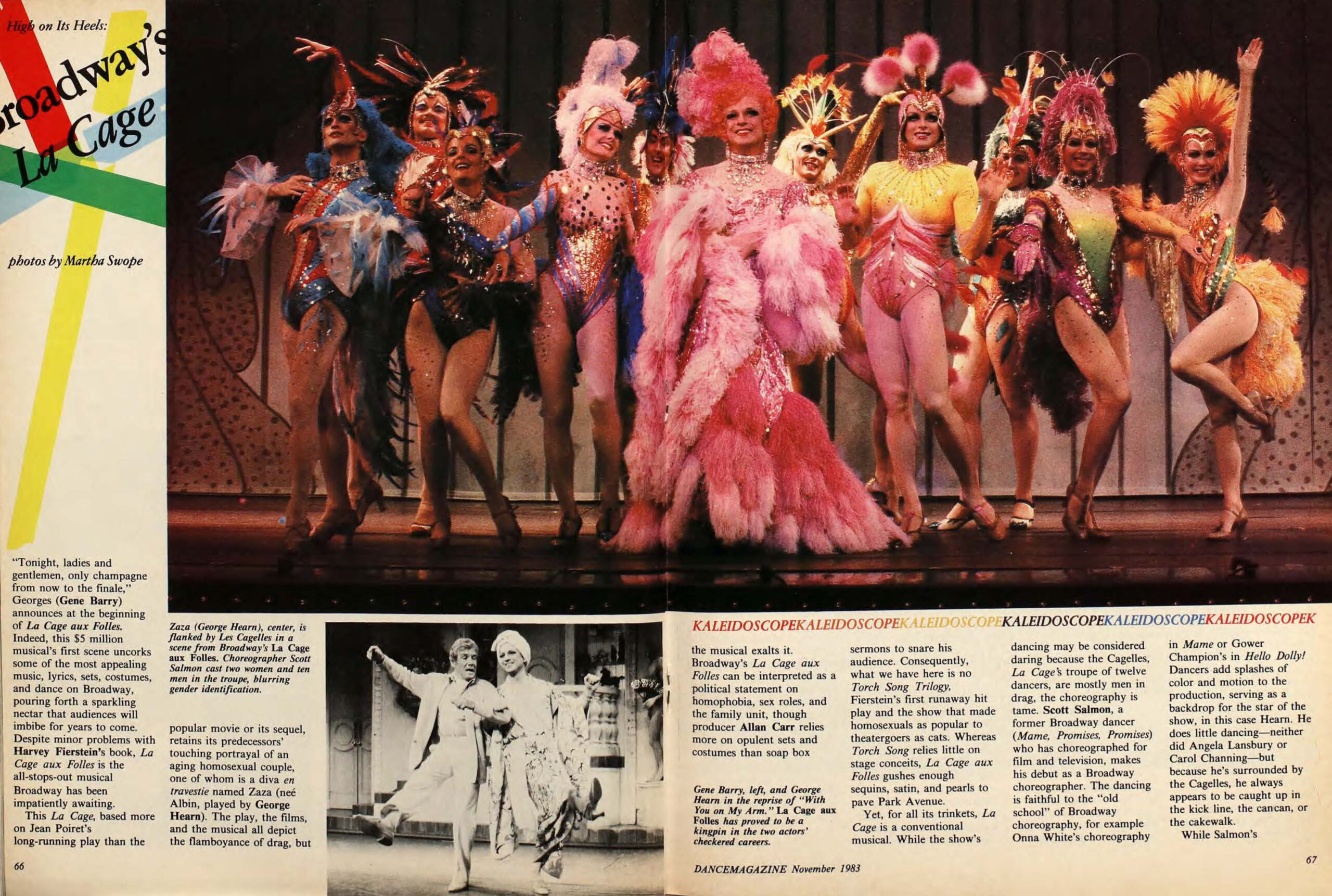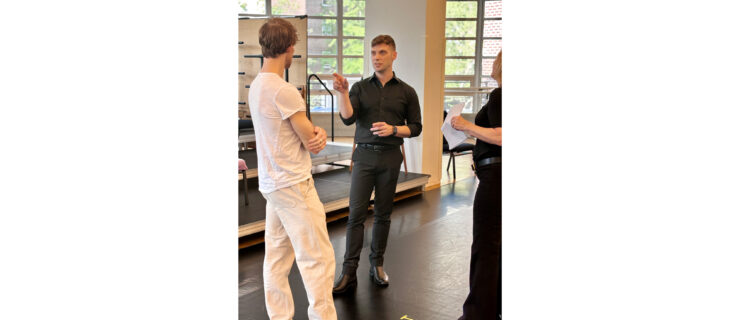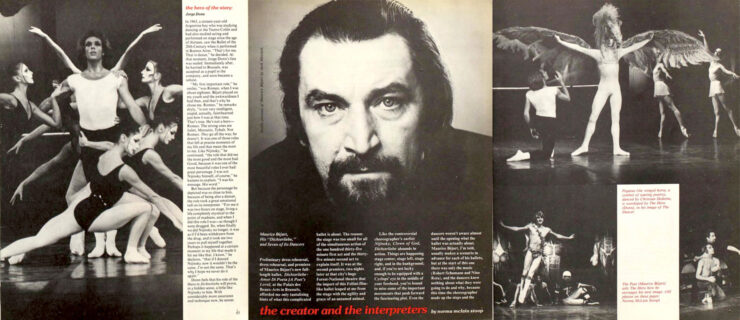La Cage aux Folles’ Cagelles, 40 Years Later: Something About Sharing, Something About Always
The groundbreaking musical La Cage aux Folles opened on Broadway 40 years ago last August. As part of the anniversary celebrations, members of the original Cagelles—the dancers who formed the drag ensemble at the heart of the show—organized a series of events in conjunction with Broadway Cares/Equity Fights AIDS.
It’s fitting that the group marked the occasion by raising money to fight HIV/AIDS. La Cage took Broadway by storm just as the AIDS pandemic reached the public’s consciousness. And as the “gay plague” swept Broadway companies, including their own, the Cagelles organized numerous benefits, some of which continue to this day.
Some of the 10 gay men and two women first cast as Les Cagelles were little more than teenagers when they joined the show. These are a few of their stories.
A Little More Mascara
Dennis Callahan (Monique): I think there were between 800 and 1,000 at the original open call. Scott Salmon, who was the choreographer, was not a New York person. So it was really like a clean slate as far as what he was seeing at these auditions.
David Engel (Hanna): I was only being seen for Jean-Michel [one of the leads]. Then they said, “We need to see you dance and in drag.” I didn’t know why. I came to the final dance call. Everybody else had learned all this choreography. I learned it on the spot.
Dan O’Grady (Odette): It got down to maybe 25 of us at the end. I had never done any drag, but I decided to show up in drag [for the final audition]. It was really, really funny. When I got into the cab, the cab driver got out, opened the door for me, called me ma’am. Then I went into the theater, and they didn’t know who I was. No one else arrived in drag.
DC: From 10 in the morning to 4 or 5 in the afternoon, we did all of the dancing in drag. And at the end of this long day, we were 12 and 12 across the stage.
DE: Basically, it was like the end of A Chorus Line. We were all lined up across the stage. And then they’re like, “Rehearsals start on this date—congratulations.” Everybody’s jumping up and down screaming, and I’m like, “What’s happening? What’s going on?”
DC: After the others left, they had the 12 of us gather around the piano and sing “There’s No Business Like Show Business” in real short-clipped piano voices. [Composer] Jerry Herman said, “This is the style of La Cage’s opening song, ‘We are What We Are.’ ” It was such a cool moment to be around the piano with Jerry and [music director] Don Pippin, all of us in drag.
Not a Place We Have to Hide
DE: The very first day of rehearsal, [director] Arthur Laurents said, “We are not doing this apologetically. We are proudly playing these roles.”
DO: He gave us all storylines. Some were more developed than others, but we all had a bit of one. He really instilled in us that we were important to the story.
DC: Though I don’t think any of us had any experience doing drag, I don’t think any Cagelle would say it was hard. The atmosphere in the room was so supportive and nurturing that none of us felt any fear of being judged.
DO: I remember Arthur working on “I Am What I Am” with George Hearn [who played Albin], a straight man. The amount of pride and dignity that Arthur conveyed not just to George but all of us was very powerful. It moves me even just to think of it now.
DC: The Cagelles were given the last bow. When does that ever happen? We each just took a humble bow as ourselves. The sound of the audience was unbelievable.
Sometimes Sweet and Sometimes Bitter

DE: We had a whole warm-up area in the basement, and at intermission, we’d dress up, we’d be ridiculous. We just kept creating and playing.
It was the best of times. And it was the worst of times.
DO: I first started hearing about the “gay cancer” when we were in Boston. Nobody knew what it was.
DE: I remember thinking to myself, if I went to a gay bar, I would hold my breath. You just didn’t know. It was everywhere, and if you tested positive, it was a death sentence, definitely. And you could go quick.
DO: I think David Cahn [Chantelle] was the first of us Cagelles who got sick and left, then John Dolf [Nicole].
DC: I don’t remember any conversation between the rest of us about the boys being sick. I think it was sort of a feeling of: If they wanted to talk about it they would, and they’re not, so neither should we. And maybe there was also a fear.
DO: We felt the loss from the inside, and I think that’s what sort of led us to start thinking about the Easter Bonnet competition. Howard Crabtree and the other costume folks did these silly Easter bonnets, and we had folks donate. In the beginning it was just the cast, the crew, and the orchestra.
DE: We did the Easter Bonnet pageant in the basement and a Queen of Hearts pageant for Valentine’s Day, both just among ourselves, and raised money for Gay Men’s Health Crisis. The next year we decided to bring the Easter Bonnet pageant onto the stage and invited other casts to come—A Chorus Line, Cats, there were a few companies. I remember when they flipped over the cards at the end, we had raised $17,000. I was sobbing, sobbing.
DO: I think we needed a sense of agency. Because there was no hope. There really wasn’t. Our friends were dying, and we couldn’t do anything about it. But we could dress up and act silly and ask people for money.
DC: Teddy Azar was instrumental in the whole look of the show makeup- and wig-wise. He was one of the first in the company to come down with AIDS. He was at St. Vincent’s, and David [Scala, who played Phaedra], Sam [Singhaus, Clo-Clo], and I got some nurse drag with these giant hypodermic needles and resuscitation devices, just ridiculous stuff, and we went down there. People who worked there came up to us and said, “Could you please come bring some of this joy into some of the other rooms?” And we went in and out of these rooms, these three big old drag queens in nurse drag, and it was joyous. The whole thing was joyous.
DE: I had plenty of hard losses, but the hardest was [executive producer] Fritz Holt. At the show that night, we silently got in place, and one by one we turned around in the opening number and we all started singing “We Are What We Are.” But then one by one voices were dropping out. We just couldn’t sing. We were all crying. The cast members in the wings on both sides were singing for us, trying to keep it going.
We Are What We Are
DC: When we would turn around one by one in the opening number, you could feel, physically, this sort of crossed-arm, furrowed-brow feeling from the audience. They were probably wondering if maybe we’re too close, we’re going to get [AIDS].
By the end of the show those same faces were leaning into the stage, wide-eyed. I left every night thinking, Wow, I think I was part of something that changed what people think about homosexuals.
DE: I came out to my mom when I was 18, and she really struggled with it. She couldn’t understand what she had done wrong. And it was La Cage that turned her around. It let her know that you can have love and family being gay. She became a mother to all of my gay friends that had parents that disowned them. They adored her, and she loved all of them.
DC: From the beginning my parents saw something in me. They would take me to the Muny Opera, to the Starlight in Kansas City, and nurtured that in me. But at the same time I didn’t ever feel like I needed to tell them I was gay. I thought the words and the situation would hurt them. And they knew.
When they saw the show, that was my way of being able to tell them and show them that I was going to be okay.
DO: La Cage changed my life. I got to work with Harvey Fierstein and Jerry Herman and Arthur Laurents and Fritz Holt and Barry Brown and Don Pippin, and George Hearn and Gene Barry [Georges] and Merle Louise [Mme. Didon]. I also learned so much from Linda Haberman [Bitelle] and Jennifer Smith [Colette]. The work ethic, the creativity, and the artistry was like nothing I had ever been exposed to.
DC: At the 40-year reunion, we sang “The Best of Times.” There were two older gentlemen sitting next to each other in the audience, and they were bawling. And I thought, god, this show affected more people than we will ever know. It’s so special to have been a part of something like that.




